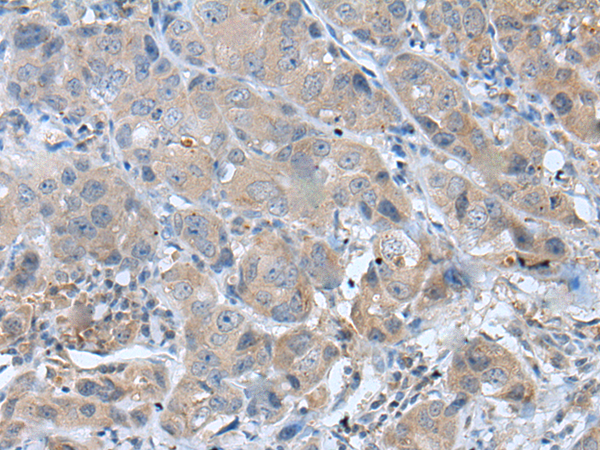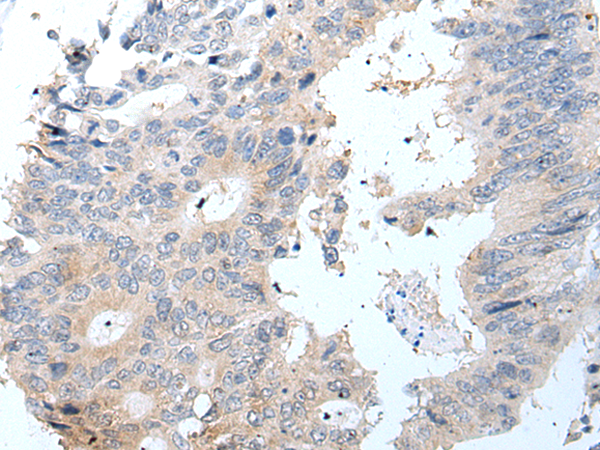

| WB | 咨询技术 | Human,Mouse,Rat |
| IF | 咨询技术 | Human,Mouse,Rat |
| IHC | 1/25-1/100 | Human,Mouse,Rat |
| ICC | 技术咨询 | Human,Mouse,Rat |
| FCM | 咨询技术 | Human,Mouse,Rat |
| Elisa | 1/5000-1/10000 | Human,Mouse,Rat |
| Aliases | MTLRP |
| Host/Isotype | Rabbit IgG |
| Antibody Type | Primary antibody |
| Storage | Store at 4°C short term. Aliquot and store at -20°C long term. Avoid freeze/thaw cycles. |
| Species Reactivity | Human, Mouse, Rat |
| Immunogen | Synthetic peptide of human GHRL |
| Formulation | Purified antibody in PBS with 0.05% sodium azide and 50% glycerol. |
+ +
以下是关于GHRL(胃饥饿素)抗体的3篇文献摘要简述:
1. **"Development of a sensitive and specific ghrelin immunoassay utilizing anti-ghrelin antibodies"**
- **作者**: Smith A, et al.
- **摘要**: 研究团队开发了一种高灵敏度和特异性的GHRL免疫检测方法,通过优化针对活性胃饥饿素(酰化形式)的多克隆抗体,成功应用于血浆样本分析,为代谢疾病研究提供工具。
2. **"Anti-ghrelin antibodies modulate feeding behavior in rodents"**
- **作者**: Tanaka M, et al.
- **摘要**: 该文献报道了使用单克隆GHRL抗体阻断胃饥饿素信号传导的实验,证明其能显著减少大鼠摄食量及体重增长,提示抗体在肥胖治疗中的潜在应用价值。
3. **"Ghrelin autoantibodies in patients with Prader-Willi syndrome"**
- **作者**: Hiejima H, et al.
- **摘要**: 研究在Prader-Willi综合征患者血清中检测到GHRL自身抗体,发现抗体水平与患者过度摄食行为呈正相关,为阐明该疾病病理机制提供了新方向。
Ghrelin, a 28-amino-acid peptide hormone predominantly secreted by the stomach, was discovered in 1999 as the endogenous ligand for the growth hormone secretagogue receptor (GHSR). It plays a critical role in regulating appetite, energy balance, and growth hormone release. Ghrelin exists in acylated (active) and des-acylated forms, with acylation mediated by ghrelin O-acyltransferase (GOAT) being essential for its biological activity. Its levels fluctuate with feeding states, rising during fasting to stimulate hunger and decreasing postprandially. Dysregulation of ghrelin signaling is linked to obesity, metabolic disorders, and eating-related pathologies.
GHRL antibodies are immunological tools targeting ghrelin or its related proteins (e.g., GHSR, GOAT). These antibodies enable researchers to quantify ghrelin concentrations, map its distribution in tissues, or block its activity in experimental models. Applications span basic research (e.g., studying energy homeostasis mechanisms), clinical diagnostics (assessing ghrelin in metabolic diseases), and drug development (evaluating therapeutic candidates). Challenges include distinguishing between ghrelin isoforms and ensuring specificity given structural similarities with other peptides. Both monoclonal and polyclonal variants exist, optimized for techniques like ELISA, immunohistochemistry, or Western blot. Recent studies also explore ghrelin's roles beyond metabolism, including cognitive function and stress responses, further driving antibody utility in interdisciplinary research.
×